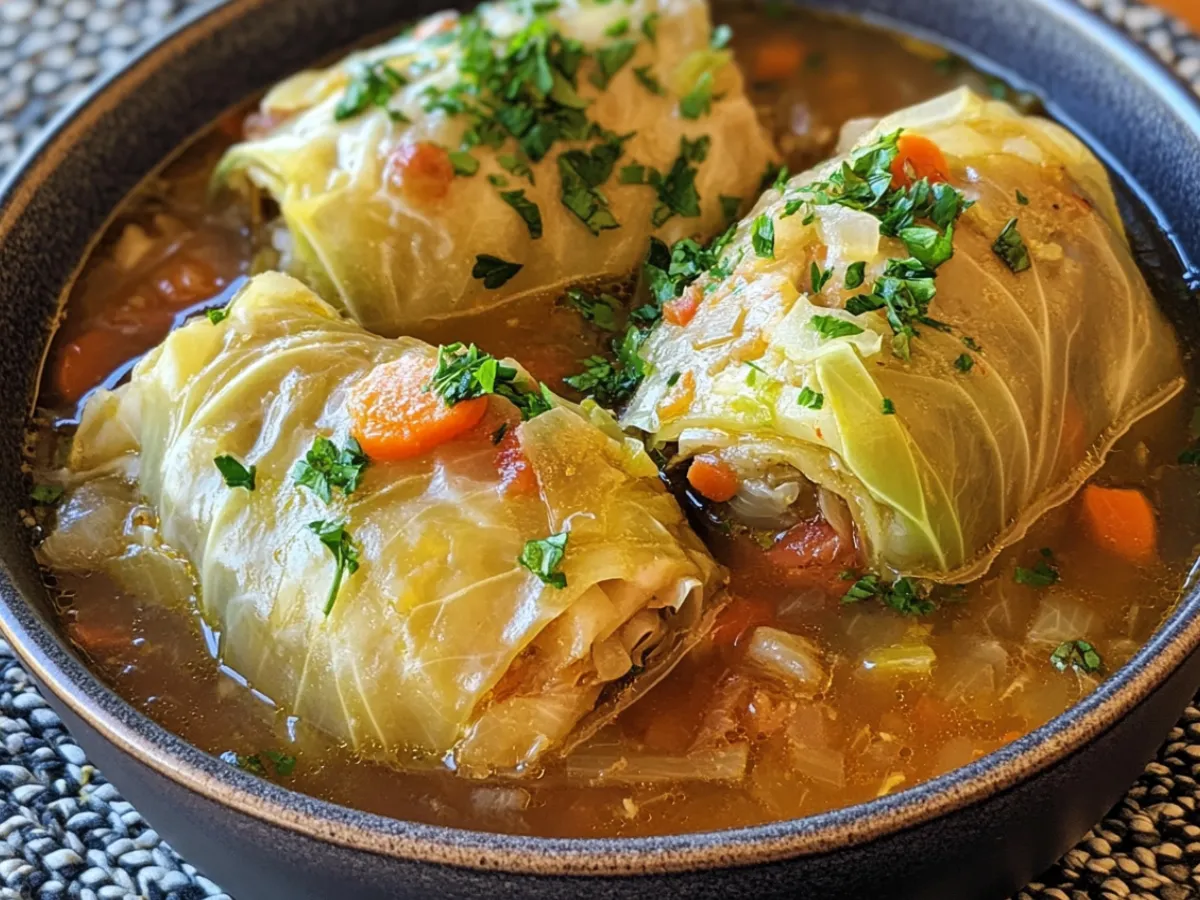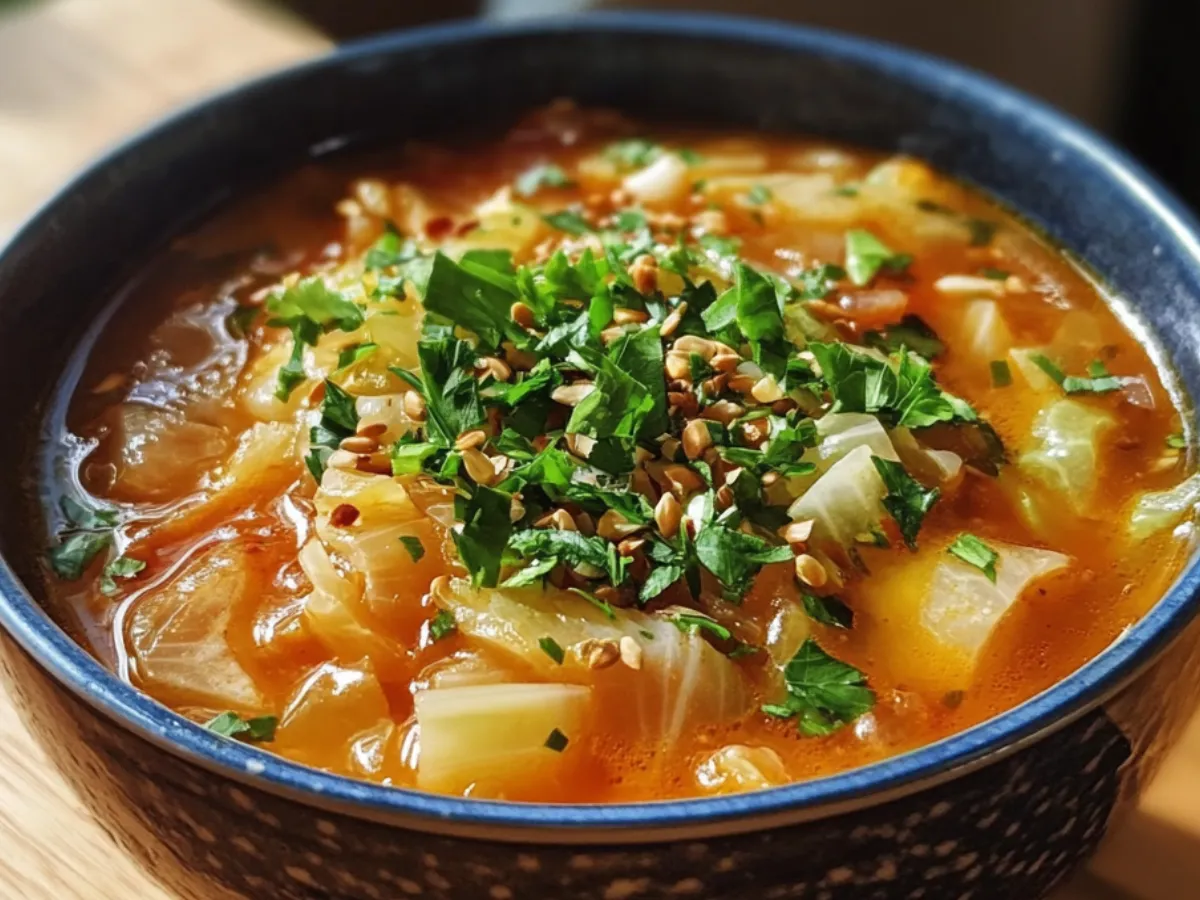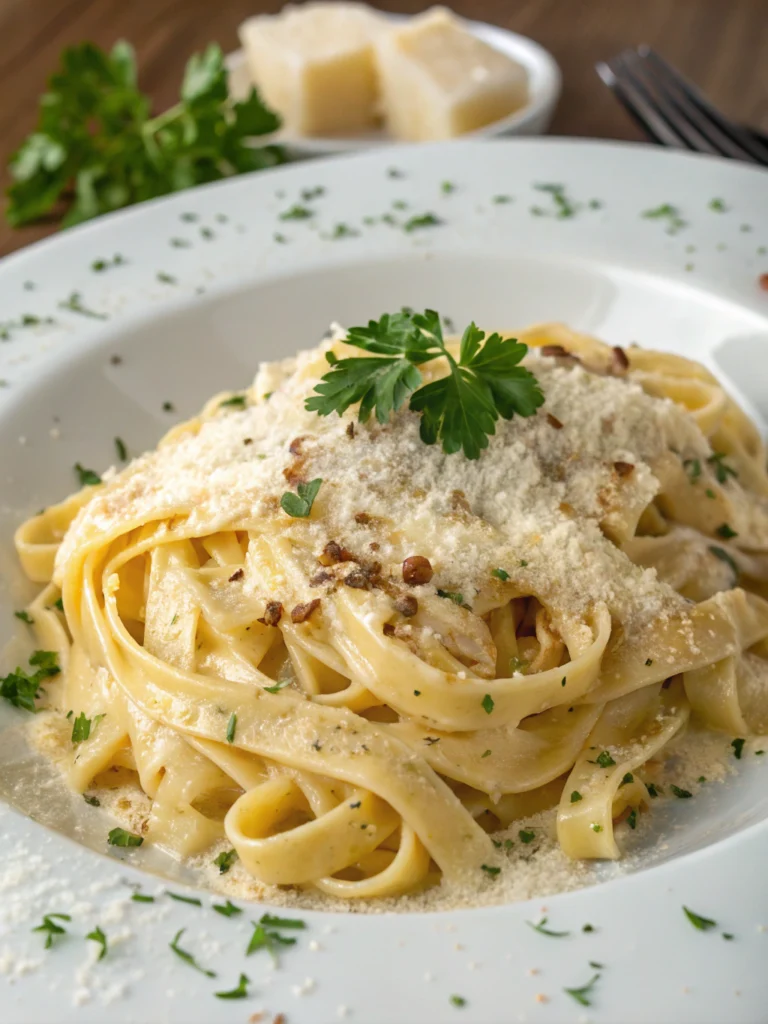I have discovered a delicious Cabbage Soup Recipe meal option that’s perfect for any time of the day. This cabbage soup is not only flavorful but also packed with healthy vegetables. The best part is that it’s incredibly simple to make.
The combination of aromatic veggies and fire-roasted tomatoes creates a rich flavor profile that’s both comforting and nourishing. Pair it with some good bread, and you have a simple yet satisfying meal. What’s more, this soup is budget-friendly and nutrient-dense, making it ideal for health-conscious home cooks.
Key Takeaways
- A nutritious and flavorful meal option that’s easy to prepare.
- Transforms an entire head of cabbage into a delicious soup.
- Offers a balance of flavors with slight sweetness and tangy elements.
- Budget-friendly and nutrient-dense, perfect for health-conscious cooks.
- Versatile for different dietary needs and preferences.
- Works well as a standalone meal or part of a larger menu.
Why This Cabbage Soup Recipe Is Worth Making
I’ve found that this cabbage soup recipe is a game-changer for a quick, nutritious meal. This cabbage soup does the impossible: it uses an entire head of cabbage in one go, making it an efficient way to enjoy this vegetable.
The efficiency of using a whole head of cabbage not only reduces food waste but also provides a budget-friendly option for a meal. The soup is deeply flavorful and comforting, making it perfect for any time of the year.
A Nutritious and Budget-Friendly Meal
This soup recipe stands out due to its high nutritional value and economic benefits. By incorporating multiple vegetables and using ingredients that are often readily available, it provides a nutritious and budget-friendly meal option.
The economic benefits of making this cabbage soup are significant. It stretches ingredients and provides multiple servings at a low cost, making it an ideal choice for those looking to save time and money.
My Experience with This Soup
In my experience, this soup has become a regular part of my meal rotation. I appreciate how the flavor develops and melds together during cooking, creating a rich and satisfying taste.
The versatility of this recipe is also noteworthy. It can be served as both a starter and a main dish, and it’s easily adaptable to use seasonal or on-hand ingredients, making it a great option for a healthy eating plan without feeling restrictive.
Health Benefits of Cabbage Soup
Cabbage soup is more than just a comforting meal; it’s a nutritional powerhouse that can transform your health. With its rich nutritional profile, cabbage soup provides a range of essential vitamins and minerals that are vital for maintaining overall well-being.
Nutritional Profile of Cabbage
Cabbage is a nutrient-dense vegetable, jam-packed with vitamins and minerals. It is an excellent source of Vitamin C, a powerful antioxidant that boosts the immune system. Cabbage is also rich in fiber, containing 1 gram of fiber for every 10 calories, which helps to promote digestive health and support healthy blood sugar levels.
Why It’s Great for Weight Management
The low-calorie, high-fiber nature of cabbage soup makes it an ideal choice for those seeking to manage their weight. The fiber content helps to keep you feeling fuller for longer, reducing the likelihood of overeating. Additionally, the combination of vegetables in the soup provides a wide spectrum of nutrients, supporting overall health and well-being.
Cabbage soup can be enjoyed as part of a balanced diet, and it’s not meant to be a restrictive regimen like the “cabbage soup diet.” Regular consumption of cruciferous vegetables like cabbage is associated with various health benefits, including weight management and improved overall health.
Ingredients You’ll Need
Gathering the right ingredients is the first step in creating a nourishing cabbage soup. The freshness and quality of these components will significantly impact the flavor and nutritional value of the final dish.
The Vegetable Base
The foundation of this cabbage soup is its vegetable base, which includes a mix of fresh vegetables. The star ingredient is, of course, cabbage – one small green cabbage (about 1 pound) is recommended. Alongside it, you’ll need the classic aromatic trio: onion, carrots, and celery. These ingredients form a mirepoix that creates the aromatic foundation for the soup.
- 1 small green cabbage (about 1 pound)
- 1 medium onion
- 2 medium carrots
- 2 stalks of celery
Herbs, Spices, and Liquids
To enhance the flavor profile, you’ll need garlic and dried thyme. For added depth, consider including potatoes and white beans for plant-based protein. The liquid components include vegetable broth and diced fire-roasted tomatoes, which form the soup’s base. A splash of white wine vinegar adds a tangy touch, while olive oil is used for sautéing the vegetables. Finally, season with salt and pepper to taste.
- 2 cloves of garlic
- 1 teaspoon dried thyme
- 2 cups vegetable broth
- 1 can diced fire-roasted tomatoes
- 1 tablespoon olive oil
- Salt and pepper to taste

Kitchen Equipment Required
Preparing cabbage soup requires some essential kitchen equipment that I’ll outline below. Having the right tools can make a significant difference in the cooking process and the final result.
Essential Tools
To make a delicious cabbage soup, you’ll need a few essential tools. A large, heavy-bottomed pot or Dutch oven is ideal for making soup, as it provides even heat distribution. This is crucial for cooking the vegetables thoroughly and preventing the soup from burning.
A good chef’s knife is also necessary for properly chopping the cabbage and other vegetables. Additionally, you’ll need measuring cups and spoons to ensure accurate ingredient proportions.
Optional but Helpful Items
While not essential, some kitchen equipment can make preparation easier. A garlic press can save time when mincing garlic, and a vegetable chopper can help with chopping the cabbage and other vegetables.
If you don’t have a Dutch oven, you can use a large pot with a heavy bottom as an alternative. For storing leftover soup, consider using airtight containers that can be refrigerated or frozen.
Step-by-Step Cabbage Soup Recipe
Now that we have all the ingredients and kitchen equipment ready, let’s dive into the step-by-step process of making a delicious cabbage soup.
Preparing the Vegetables
The first step in making our cabbage soup is to prepare the vegetables. This involves chopping the cabbage, onion, carrots, and celery. To chop the cabbage, remove the outer leaves and cut it into quarters, removing the core. Then, slice the quarters into thin strips. For the onion, carrots, and celery, peel and chop them into bite-sized pieces.
Building the Flavor Base
To build the flavor base of our soup, heat olive oil in a large pot over medium heat. Add the chopped onion, carrots, and celery, along with a pinch of salt and pepper. Cook for 8 minutes, stirring occasionally, until the vegetables are tender and fragrant.
Adding Cabbage and Liquids
Next, add the chopped cabbage, garlic, tomatoes, broth, and any other desired ingredients to the pot. Stir well to combine, then bring the mixture to a simmer.
Simmering and Final Touches
Reduce the heat to low and let the cabbage soup simmer for 20-30 minutes, or until the cabbage and other vegetables are tender. Season the soup to taste, then garnish with fresh herbs and serve hot.
By following these steps, you’ll have a delicious and nutritious cabbage soup that’s perfect for any meal. Enjoy!
Delicious Variations to Try
The basic cabbage soup recipe is just the starting point for numerous delicious variations. By incorporating different ingredients and flavor profiles, you can create a unique soup that suits your taste preferences and dietary needs.
Adding Protein Options
One way to enhance your cabbage soup is by adding protein. You can use shredded chicken, diced baked chicken breast, or even carnitas for a richer flavor. For plant-based options, consider adding white beans, chickpeas, or lentils. When adding protein, it’s essential to balance it with the vegetable-forward nature of the soup.
For example, you can add cooked chicken or ground beef towards the end of the simmering process to prevent overcooking. If using plant-based proteins like beans or lentils, you may need to adjust the cooking time accordingly.
Different Vegetable Combinations
Experimenting with various vegetables can keep your cabbage soup fresh and exciting. Consider adding bell peppers for a sweet crunch or zucchini for added moisture. Leafy greens like kale or spinach can be added towards the end of cooking to preserve their nutrients.
Seasonal vegetable substitutions can also help in maintaining the soup’s freshness. For instance, during summer, you can add more summer squash or green beans, while in winter, root vegetables like carrots or parsnips can be great additions.
Spice and Flavor Adjustments
Adjusting the spice and flavor profile can completely transform your cabbage soup. For a spicy kick, add cayenne pepper or red pepper flakes. To give it an Eastern European twist, incorporate fresh rosemary and thyme. You can also experiment with different herbs and spices to create Asian or Mediterranean flavor profiles.
Making the soup heartier is another way to vary it. Adding potato chunks or cooked rice can make it more filling. You can also adjust the consistency from brothy to more stew-like by modifying the liquid content or adding thickening agents.
Storage and Meal Prep Tips
Once you’ve made your cabbage soup, learning how to store and reheat it can save time and reduce waste. Proper storage is key to maintaining the quality and safety of your soup.
Refrigerating Leftovers
To store leftover cabbage soup in the refrigerator, allow it to cool to room temperature first. This helps prevent bacterial growth and keeps the soup fresh. Transfer the cooled soup to an airtight container and store it in the refrigerator. Your cabbage soup will typically last for up to 4 days when stored properly in the fridge.
When refrigerating, it’s essential to check the soup for signs of spoilage before consumption. If you notice any off smells, slimy texture, or mold growth, it’s best to err on the side of caution and discard the soup.
Freezing for Later
For longer-term storage, consider freezing your cabbage soup. To freeze, cool the soup to room temperature, then transfer it to freezer-safe containers or airtight freezer bags. Be sure to leave some space at the top of the container, as the soup will expand when frozen.
When freezing in portions, consider using smaller containers or bags, making it easier to thaw and reheat only what you need. Frozen cabbage soup can be stored for up to 3 months.
Reheating Instructions
To reheat your stored cabbage soup, you have a few options. For refrigerated soup, simply heat it on the stovetop over medium heat, stirring occasionally, until warmed through. This typically takes around 5-10 minutes.
For frozen soup, allow it to thaw overnight in the refrigerator before reheating. You can also reheat frozen soup directly in the microwave or on the stovetop, though this may take a few more minutes. When reheating, make sure the soup reaches a minimum temperature of 165°F (74°C) to ensure food safety.
To refresh the flavor of leftover soup, consider adding a squeeze of fresh lemon juice or a sprinkle of herbs like parsley or thyme. You can also repurpose leftover cabbage soup into new meals, such as using it as a base for other soups or stews, or as a sauce for grains or vegetables.
One of the benefits of cabbage soup is that its flavor often improves after a day or two in the refrigerator, making it a great candidate for meal prep. By making a large batch, you can enjoy multiple servings throughout the week, saving time and reducing the need for last-minute meal decisions.
For meal prep, consider portioning out individual servings into containers, making it easy to grab and go for lunches or dinners. When transporting the soup, use insulated containers with ice packs to keep it cool and safe.
- Cool soup to room temperature before refrigerating or freezing.
- Use airtight containers for refrigerating and freezer-safe containers for freezing.
- Label containers with the date and contents.
- Reheat soup to 165°F (74°C) to ensure food safety.
Conclusion: Enjoy Your Homemade Cabbage Soup
In conclusion, this cabbage soup is not just a meal, it’s an experience that combines flavor, health, and comfort. With its simplicity and numerous benefits, it’s sure to become a favorite in your kitchen.
The cabbage soup recipe we’ve explored is deeply flavorful and comforting, making it perfect for any time of the year. It’s healthy, nourishing, and remarkably simple to prepare. You can enjoy it with crusty bread, a sandwich, or a salad for a more substantial meal.
By making this soup a regular part of your meal rotation, you’ll not only be treating your taste buds but also nourishing your body with wholesome ingredients. I encourage you to experiment with different variations, adding your favorite proteins or adjusting the flavor to suit your preferences.
As you savor each spoonful of this delightful cabbage soup, remember the satisfaction that comes from creating a nutritious, homemade meal. I invite you to share your experiences and variations with this recipe, making it your own and enjoying the comfort it brings.
FAQ
How long can I store leftover cabbage soup in the fridge?
You can store it in the fridge for up to 3-4 days. Make sure to reheat it to a minimum temperature of 165°F (74°C) before consumption.
Can I freeze cabbage soup, and if so, for how long?
Yes, you can freeze it for up to 3 months. When you’re ready to eat it, simply thaw and reheat it to the desired temperature.
Is cabbage soup suitable for a low-carb diet?
Yes, it’s relatively low in carbs, making it a great option for a low-carb diet. However, be mindful of the ingredients you add, such as tomatoes or carrots, which can increase the carb count.
Can I make this soup in a slow cooker?
Absolutely! Simply sauté the onion, garlic, and other initial ingredients in a pan, then transfer everything to the slow cooker and let it simmer on low for 6-8 hours.
How can I adjust the spice level to my liking?
You can add more or less red pepper to suit your taste preferences. Additionally, you can experiment with different herbs and spices to create the perfect flavor profile for you.
Can I use chicken broth instead of vegetable broth?
Yes, you can use chicken broth as a substitute, but keep in mind that it will change the flavor profile slightly. If you’re looking for a vegetarian or vegan option, vegetable broth is the better choice.
How many servings does this soup make?
This soup makes approximately 4-6 servings, depending on serving size. You can easily scale up or down the ingredients to suit your needs.
Can I add other vegetables to the soup?
Yes, feel free to experiment with different vegetable combinations to create your perfect blend. Some great options include celery, carrots, and other leafy greens.







